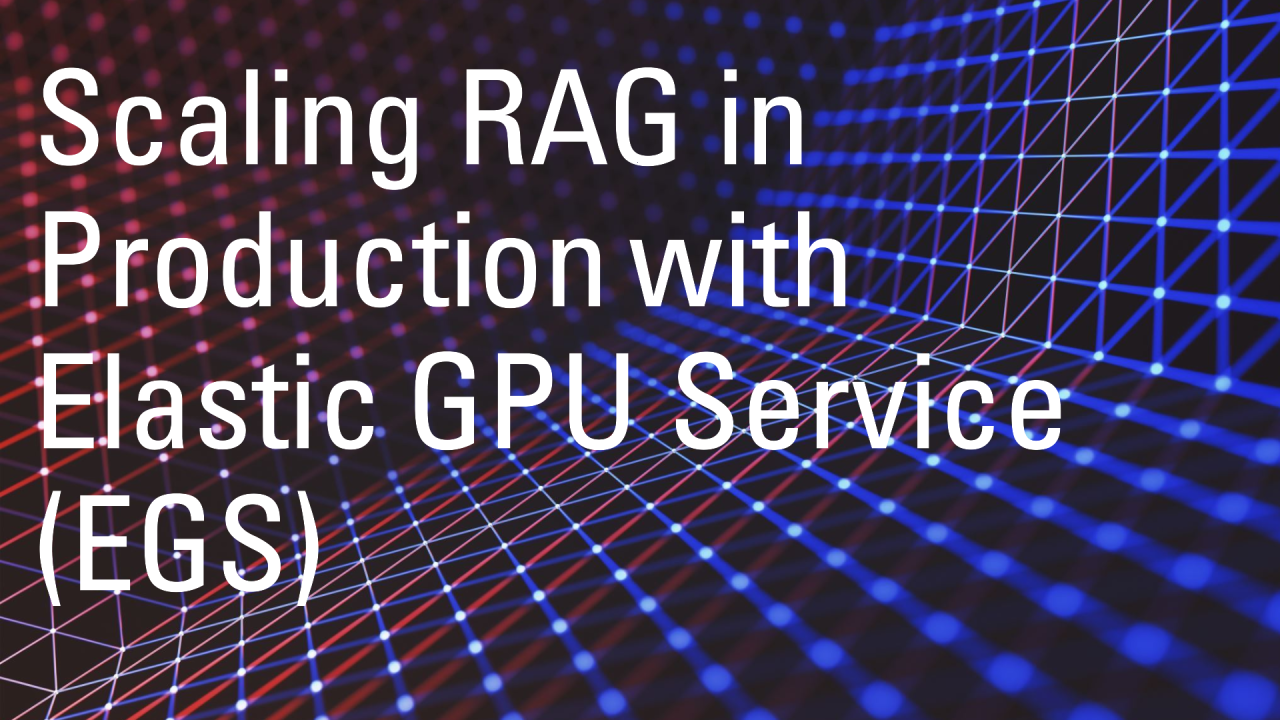
The Challenge of Scaling Retrieval-Augmented Generation (RAG) in Production and How Avesha - Elastic GPU Services (EGS) Solves It
In AI, Retrieval-Augmented Generation (RAG) is revolutionizing how organizations handle complex queries, delivering precise, context-aware responses by blending retrieval techniques with generative models. It empowers businesses to tap into vast knowledge bases in real time, creating human-like responses instantly. But the real challenge comes when scaling RAG in production—managing resources, maintaining efficiency, and ensuring top-tier performance becomes a major hurdle.
Avesha - Elastic GPU Services (EGS) steps in to solve these pain points. With a fully managed, scalable, and automated solution, EGS tackles the complexities of scaling RAG head-on. By leveraging observability, automation, and AI-driven orchestration, EGS ensures your RAG operations run smoothly, efficiently, and cost-effectively.
The Challenges of Scaling RAG in Production
RAG combines two computationally intensive processes: retrieval and generation. Each process alone can be taxing on GPU resources, and when combined in a real-time production environment, the complexity intensifies. Here’s why scaling RAG in production can be so challenging:
1. Resource Overload
RAG requires extensive GPU resources for both the retrieval of information and the generation of natural language responses. This is especially true in scenarios where large datasets are involved, and retrieval models need to sift through millions of documents or embeddings. The process puts enormous pressure on GPU resources, leading to over-provisioning to ensure performance, which can skyrocket operational costs.
2. Latency Sensitivity
In a production environment, users expect real-time responses. RAG models, however, may experience latency due to the dual nature of retrieval and generation. Latency increases when there’s contention for GPU resources, particularly when multiple instances are trying to retrieve and generate simultaneously.
3. Dynamic Workload Variability
The workload in a RAG-based system can vary dramatically based on user demand. High traffic can overload GPU resources, while periods of low activity leave GPUs underutilized. Balancing resource allocation and scaling dynamically is a significant challenge, leading to either performance bottlenecks or wasted resources.
4. Monitoring and Troubleshooting
The complexity of managing both retrieval and generation in real time makes monitoring and troubleshooting incredibly difficult. Without visibility into how GPU resources are being utilized and how different workloads are performing, identifying and resolving performance bottlenecks becomes a slow and laborious process.
5. Operational Overhead
Maintaining a RAG system at scale requires ongoing management—optimizing GPU utilization, scaling resources up and down, and resolving operational issues. This adds to the operational overhead, requiring skilled resources and specialized expertise.
How EGS Tackles RAG Scaling Challenges Holistically
Elastic GPU Services (EGS) is uniquely equipped to address the challenges of scaling RAG in production environments. By offering observability, automation, and AI-driven orchestration, EGS provides a comprehensive solution that not only optimizes resource management but also enhances the overall efficiency and reliability of RAG systems.
领英推荐
1. Observability: Deep Insights for Real-Time Performance Management
One of the biggest hurdles in scaling RAG is the lack of visibility into how GPU resources are being utilized across both the retrieval and generation stages. EGS offers end-to-end observability, giving you real-time insights into how your workloads are performing.
2. Automation: Streamlining Resource Management
Scaling RAG requires dynamic and continuous adjustment of resources to match workload demands. Manually managing this process is not only error-prone but also inefficient. EGS offers built-in automation to handle resource allocation and scaling seamlessly.
3. AI-Driven Orchestration: Intelligent Resource Allocation
AI plays a critical role in optimizing RAG systems, particularly when it comes to AI-driven orchestration. EGS uses machine learning algorithms to intelligently manage GPU resources, ensuring that critical jobs are prioritized, and performance remains consistent even under varying loads.
?
Competitive Differentiation of EGS
Elastic GPU Services (EGS) stands out from competitors by offering a fully managed, GPU & Cloud -Agnostic platform that combines real-time observability, automation, and AI-driven orchestration into one comprehensive solution. Unlike other services that may lock you into proprietary hardware or lack flexibility, EGS provides multi-cloud compatibility and seamless integration with existing infrastructure, giving customers the freedom to choose the best GPUs for their workload. Additionally, the self-healing capabilities and dynamic scaling of EGS ensure uninterrupted performance, even under varying loads, which many other providers struggle to offer at scale. From a product perspective, EGS's cost optimization engine and predictive analytics enable smarter resource utilization, lowering costs while improving performance, making it the best choice for scaling RAG systems without the complexity of manual intervention.
The Holistic Advantage of EGS for RAG Scaling
The combination of observability, automation, and AI-driven orchestration provides a holistic solution to the challenges of scaling RAG in production environments. By leveraging EGS, organizations can achieve:
EGS is Your Ultimate Solution for Scaling RAG and Beyond
Scaling RAG in production environments is no small feat, but with Avesha-EGS, it's not just possible—it's seamless, efficient, and optimized for cost and performance. EGS offers a comprehensive solution with real-time observability, powerful automation, and AI-driven orchestration, uniquely designed to handle the complexities of RAG at scale. Whether you're managing routine queries, processing millions of documents, or running advanced LLM/SLM models and Inference at scale, EGS ensures your system performs at its peak, with the flexibility and intelligence to adapt to changing workloads in real time. With EGS, you get a future-proof platform that’s tailored for scaling RAG, LLMs, and more—guaranteeing unmatched reliability and efficiency in every deployment.
Helping the enterprise optimize Kubernetes deployments using precision AI. Cloud FinOps—multi-cluster Cost Management—Secure multi-cluster communication. Smart Scaler, KubeTally, KubeAccess, KubeSlice (CNCF)
2 个月Very informative!
Great explanation on the problems faced with GPU scaling and a solution addressing these complex issues…..well done.
Co-Founder of Altrosyn and DIrector at CDTECH | Inventor | Manufacturer
2 个月Scaling RAG systems is indeed a common hurdle for many researchers and developers. The need for both efficient retrieval and powerful generation can put a strain on resources. What specific strategies within EGS have you found most effective in mitigating latency issues?